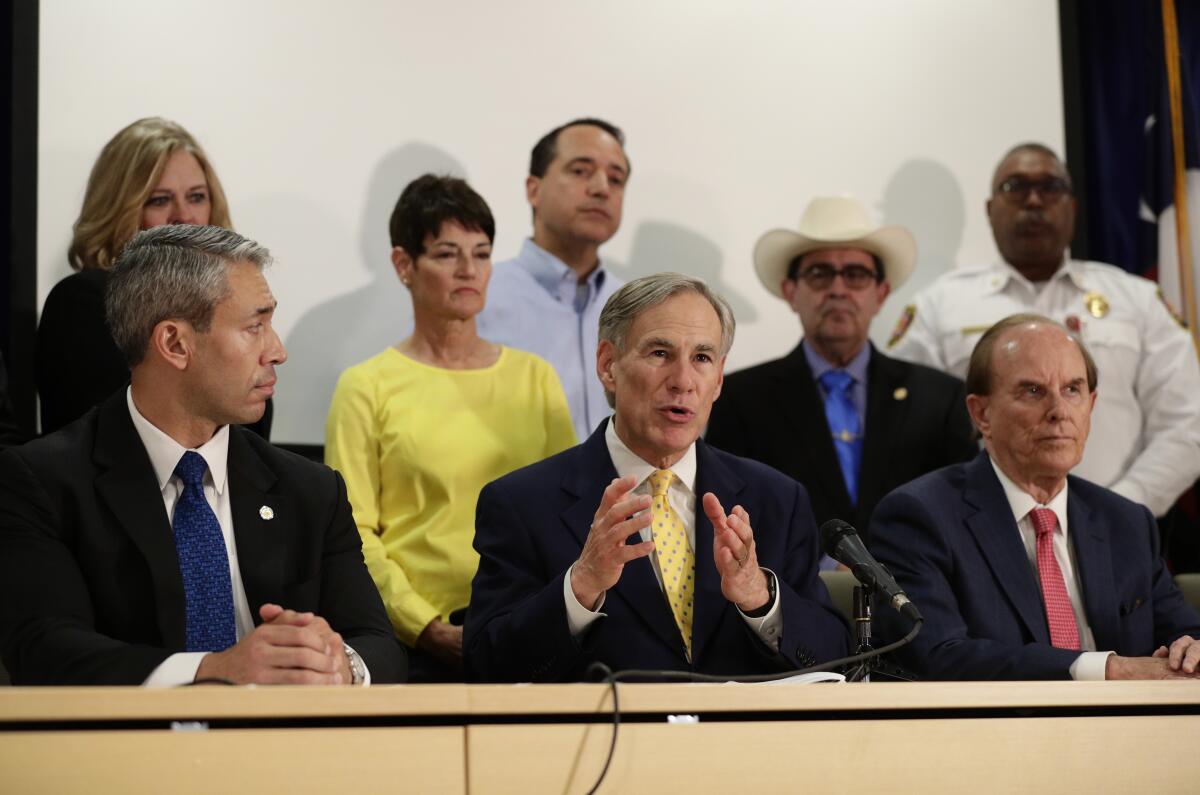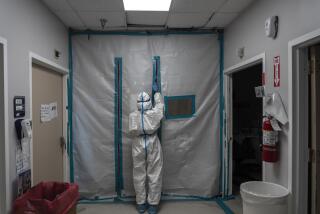Will Texas or Florida be ‘the next Italy’? Red states lag blue in stay-at-home orders
- Share via
HOUSTON — Gavin Newsom was the first governor to order his citizens to stay at home, shutting down California’s economy, the world’s eighth-largest, in the face of the COVID-19 pandemic. The next day, Friday, Andrew Cuomo, the governor of New York, followed suit.
But not so in Texas and Florida, the nation’s second and third most populous states, where a small-government philosophy — less taxes, fewer regulation and a weaker safety net — has long held sway.
About one-fifth of Texas’ 29 million people lacks health insurance, and nearly one-quarter of Florida’s 21 million residents are elderly. But the governors of those states have resisted stay-at-home orders, despite mounting criticism.
Urban mayors in both states have canceled events like Miami’s Ultra electronic music festival and Austin’s South by Southwest and have opened a handful of testing sites. They complain the patchwork of policies has made it nearly impossible to limit the disease’s spread.
But the governors, who are Republican, fear overreacting.
“The vast, vast majority of people are testing negative for this,” Florida Gov. Ron DeSantis said at a Sunday briefing at one of the state’s three coronavirus test sites.

Texas Gov. Greg Abbott has pointed to the state’s vast rural stretches in arguing against ordering residents to stay home.
“What may be right for places like the larger urban areas may not be right for the more than 200 counties that still have zero cases of COVID-19,” Abbott said.
Officials in Houston, San Antonio and Dallas, the state’s largest cities, disagree. On Monday, San Antonio issued a stay-at-home order and Austin was expected to follow suit on Tuesday.
“I’m hopeful the governor will reconsider,” Clay Jenkins, the Dallas County judge, or chief executive, said at a Sunday briefing.
There, Jenkins displayed a chart showing the projected spread of the coronavirus far exceeded Texas’ available hospital beds. According to the projection, a statewide stay-at-home order could decrease coronavirus deaths from 430,000 to 5,000.
He noted that Dallas has 250,000 uninsured residents, the most of any U.S. city.
“Those folks aren’t going to the doctor. If we don’t do something it’s going to be very, very bad here,” he said.
On Sunday, Abbott created a “strike force” of public and private sector officials to get Texas more medical supplies and deployed National Guard troops to assist local test sites. He promised that Texas would soon perform up to 20,000 coronavirus tests a week — but in Dallas County, just a couple of hundred of people had been tested, said Dallas Mayor Eric Johnson.
“The availability of testing isn’t there,” he said.
Johnson, a former state legislator elected mayor last year, has faced tough decisions since the start of the crisis, when he canceled the city’s St. Patrick’s Day parade. He and Houston’s mayor, Sylvester Turner, declared emergencies before the governor did, but he said the orders have been difficult to enforce without statewide support.
“It makes all the economic pain you’re inflicting on one city a wasted effort if a neighboring city is doing something different — if people are continuing to congregate on the other side of an imaginary line,” he said. “The approach probably should have been statewide from the outset. I think the governor is there now.”
Turner declined to issue a stay-at-home order Monday, citing the need for “economic balance.”
“In some cases, for many people, that can be worse than the virus itself,” he said.
Lina Hidalgo, the county judge for Harris County, which includes Houston, said local officials had planned to create 10 testing sites, but the federal government only sent enough supplies for four and they were delayed. As of Monday, three test sites had opened capable of testing up to 250 people a day with results taking several days.
“We do expect there to be a waiting list,” Hidalgo said. “There is a triage process going on behind the scenes.”
Hidalgo has been conferring with officials in California and Washington as she tries to increase testing capacity. With testing so limited, she said, “All we have left is the blunt tool of social distancing.”
Hidalgo worries Texas will soon look like Italy, with rampant coronavirus infections and deaths, especially in places like the county jail.
“Italy has an award-winning healthcare system. We have 20% uninsured,” she said. “They’re overwhelmed. You can bet we’d be overwhelmed if we saw the kind of spike they’ve seen.”
In Texas, drive-through coronavirus testing just started Thursday and has been slow to expand, even in Dallas and Houston, where police and firefighters have tested positive for the virus.
So far, 10,000 Texans have been tested, less than half of California’s number. New York is now testing 16,000 daily and has tested 75,000 total.
Even Florida, a small-government state led by Republicans with a smaller population of about 20 million, had tested more people than Texas as of Sunday.
“The unknown is whether every city is going to look like New York in a couple weeks, or whether we’ve interrupted community spread,” said Dr. Peter Hotez, dean of the School of Tropical Medicine at Baylor College of Medicine in Houston. “Without the testing, it’s hard to know.”
The first coronavirus case was reported in a Houston suburb on March 4, about a month after California.
Two days after California’s first confirmed COVID-19 fatality, Gov. Gavin Newsom convened top officials and ran a series of “scenarios for worst-case spread” and created pandemic response plans, he later said.
Newsom declared a statewide emergency and sought both early federal assistance — asking for protective masks from the CDC — and community compliance through new rules for elder care and caution in attending large events. He ordered more help for seniors, renters and the homeless; delayed income tax filings and loosened rules on commercial trucking and election procedures.
But in Texas, Abbott waited until Thursday to issue an order closing schools and dine-in restaurants and limiting gatherings to 10 people, as of Saturday.
“The traditional disaster model we have applied for so long does not apply,” Abbott conceded in announcing the measures. “What we’re dealing with now is not a local disaster: It’s an international pandemic.”
The same day, Newsom ordered all of California’s 40 million residents to stay home for two weeks. The next day, Cuomo issued a similar order covering 19 million residents of New York. In the last three days, other states have followed suit with stay-at-home orders: Illinois, New Jersey, Louisiana, Ohio, Delaware, Indiana, Michigan, Oregon, Washington and West Virginia.
Louisiana’s governor, John Bel Edwards, a Democrat, warned coronavirus is spreading faster there than anywhere else in the world, with more cases per capita than any state other than Washington and New York. He said they were on pace to run out of hospital beds in as soon as a week.
“There’s no reason the believe we won’t be the next Italy,” he said Sunday.
Newsom has said California needs 20,000 additional hospital beds; Cuomo said New York needs an additional 50,000. Both said they don’t have enough life-saving ventilators needed to treat critical coronavirus patients. New York state has at least 5,000, but expects to need about 30,000, Cuomo has said.
“Ventilators are to this war what missiles were to World War II,” he said Friday.
Abbott has yet to address Texas’ ventilator supply. He has praised the president’s handling of the outbreak, waited to issue a disaster declaration and activate the National Guard and was still investigating Sunday how to add hospital beds.
On Sunday, he ordered elective hospital procedures postponed (a day after Dallas County officials did) and suspended regulations limiting hospital room capacity.
“These orders will free up countless hospital beds across the state of Texas to treat COVID-19 patients,” he said, although it wasn’t clear how many added beds would be provided.
Texas has 2.9 hospital beds per 1,000 people, about the national average according to regulators. That’s less capacity than Italy (3.2 beds per 1,000 people) where hospitals have been overwhelmed by coronavirus, and far less than South Korea (12 beds per 1,000 people).
The looming shortage has alarmed local Texas officials.
While the California Legislature approved up to $1 billion in emergency spending on coronavirus efforts — a plan that was written and enacted in a matter of hours with broad bipartisan support — Abbott has yet to commit to tapping the state’s rainy day fund of more than $11 billion to help the unemployed or issue a special open enrollment for health insurance, as California and New York have. Texas’ legislature meets every other year — in the interest of small government — and isn’t due to reconvene until January unless Abbott calls a special session.
“You’ve had a state government that for weeks has been hands off and trailing behind the crisis,” said Manny Garcia, executive director of the Texas Democratic Party.
In Florida, DeSantis refused to issue a stay-at-home order, despite pleas from local leaders and Nikki Fried, the state agriculture commissioner, who warned in a letter last week that, “We cannot afford to lose another week.”
Miami Mayor Francis Suarez closed dine-in restaurants and bars March 16 only to see people continue to party to the north on Fort Lauderdale beaches.
“It’s frustrating, because you get blamed for things that you have no say over,” said Suarez, a Republican who is self-quarantined at home after testing positive for the virus.
Suarez has posted videos online encouraging Floridians to stay at home, but said he’s not he can legally order them to do so the way the governor can.
Some state parks and beaches remained open this weekend, including Pepper Park Beach on the Treasure Coast north of West Palm Beach.
Jim Crist, 58, had heard about the first local coronavirus infection earlier that day. But he and his wife still came to the beach to celebrate his birthday, sharing subs and scotch with friends after their favorite seafood restaurant closed its dining room Friday.
“We’re being safe. We’re distancing. Just let us have this,” Crist said.
On Monday, the beach was closed along with all others in St. Lucie County.
It’s not clear Florida and Texas officials realize how dire the situation already is.
On March 15, North Texas nursing home resident Patrick James, 77, died at a Dallas-area hospital, a day after he was tested for COVID-19.
“At the time we were in a little bit of a family panic to get some action,” said stepson Greg Brandt, 55.
He said the state “sprang into action.” Abbott visited and “promised to get everyone tested,” including his mother Jean James, 75, a retired teacher who had self-quarantined.
But the family didn’t receive results of James’ test until days after he died.
Hennessy-Fiske reported from Houston and Kaleem from St. Lucie County, Fla. Times staff writers John Myers in Sacramento and Meredith Blake in New York contributed to this report.
More to Read
Sign up for Essential California
The most important California stories and recommendations in your inbox every morning.
You may occasionally receive promotional content from the Los Angeles Times.












